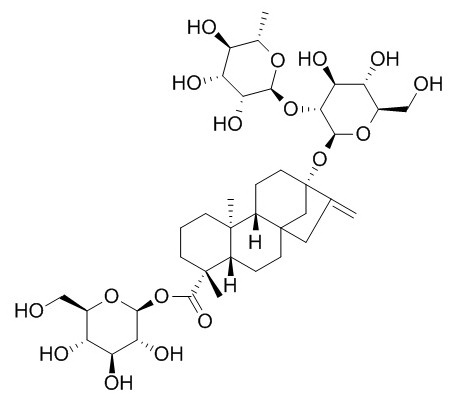Dulcoside A
Dulcoside A is a sweetener and has antioxidant activity.
Inquire / Order:
manager@chemfaces.com
Technical Inquiries:
service@chemfaces.com
Tel:
+86-27-84237783
Fax:
+86-27-84254680
Address:
1 Building, No. 83, CheCheng Rd., Wuhan Economic and Technological Development Zone, Wuhan, Hubei 430056, PRC
Providing storage is as stated on the product vial and the vial is kept tightly sealed, the product can be stored for up to
24 months(2-8C).
Wherever possible, you should prepare and use solutions on the same day. However, if you need to make up stock solutions in advance, we recommend that you store the solution as aliquots in tightly sealed vials at -20C. Generally, these will be useable for up to two weeks. Before use, and prior to opening the vial we recommend that you allow your product to equilibrate to room temperature for at least 1 hour.
Need more advice on solubility, usage and handling? Please email to: service@chemfaces.com
The packaging of the product may have turned upside down during transportation, resulting in the natural compounds adhering to the neck or cap of the vial. take the vial out of its packaging and gently shake to let the compounds fall to the bottom of the vial. for liquid products, centrifuge at 200-500 RPM to gather the liquid at the bottom of the vial. try to avoid loss or contamination during handling.
Industrial Crops and Products2018, 353-362
PLoS One.2017, 12(8):e0181191
Toxicol In Vitro.2023, 86:105521.
Antibiotics (Basel).2024, 14(1):8.
Nutrients.2024, 16(14):2267.
Molecules.2024, 29(6):1392.
ACS Nano.2018, 12(4):3385-3396
Antioxidants (Basel).2020, 9(11):1121.
Chem Biol Interact.2022, 368:110248.
Pharm Biol.2021, 59(1):134-145.
Related and Featured Products
J Med Food . 2016 Sep;19(9):844-52.
Evaluation of the Antihyperglycemic Effect of Minor Steviol Glycosides in Normoglycemic and Induced-Diabetic Wistar Rats[Pubmed:
27513814]
Abstract
Steviol glycosides are a family of compounds found in Stevia rebaudiana Bertoni that are responsible for sweetness capacity. The antihyperglycemic effect of the two major steviol glycosides, Rebaudioside A and Stevioside, has been studied and it has been found that despite having the same common structure, only Stevioside exerts an antihyperglycemic effect. Although other steviol derivatives are found in smaller amounts (minor steviol glycosides) in S. rebaudiana, whether or not they possess antihyperglycemic activity has not been evaluated. The aim of this study was to evaluate the antihyperglycemic effect of minor steviol glycosides in normoglycemic and diabetic (streptozotocin/nicotinamide) Wistar rats. Rats were subjected to an intraperitoneal glucose tolerance test (IPGTT) both before and after chronic treatment (28 days). After 6 h of fasting, IPGTT was conducted in pentobarbital-anesthetized rats using 1 g/kg of glucose plus 20 mg/kg of the minor glycoside (Dulcoside A, Rebaudioside B, C, D, or Steviolbioside) or control treatment (distilled water, glibenclamide, or metformin); the blood of the tip of the tail was collected at time 0, 15, 30, 60, and 120 min.; and blood glucose was measured, and its net area under the curve (AUCnet) was calculated. After 28-day chronic oral administration, IPGTT was again performed. Differences were considered significant at P < .05 by one-way ANOVA. Acute intraperitoneal or chronic oral administration of 20 mg/kg of minor steviol glycosides had no antihyperglycemic effect in normoglycemic or induced-diabetic Wistar rats. Considering the dose tested, it is unlikely that these glycosides have an effect on glucose in diabetic or normoglycemic humans.
Keywords: Stevia rebaudiana; antihyperglycemic; dulcoside; rebaudioside; steviol glycosides; steviolbioside.
Food Chem., 2015, 172(172):1-6.
The application of different drying conditions (hot air drying at 100 °C and 180 °C, freeze drying and shade drying) on steviol glycosides (stevioside, dulcoside A, rebaudioside A and rebaudioside C) and antioxidants in Stevia leaves was evaluated. Stev[Pubmed:
25442516]
The application of different drying conditions (hot air drying at 100 °C and 180 °C, freeze drying and shade drying) on steviol glycosides (stevioside, Dulcoside A, rebaudioside A and rebaudioside C) and antioxidants in Stevia leaves was evaluated.
METHODS AND RESULTS:
Stevioside, the major glycoside found in fresh leaves (81.2mg/g), suffered an important reduction in all cases, although shade drying was the least aggressive treatment. Considering the antioxidant parameters (total phenols, flavonoids and total antioxidants), the most suitable drying method was hot air at 180 °C, since it substantially increased all of them (76.8 mg gallic acid, 45.1mg catechin and 126 mg Trolox, all equivalent/g Stevia, respectively), with respect to those present in fresh leaves (44.4, 2.5 and 52.9 mg equivalent/g).
CONCLUSIONS:
Therefore, the ideal method for drying Stevia leaves depends on their final use (sweetener or antioxidant), although, hot air at 180 °C is the most recommendable if only one treatment has to be chosen.



